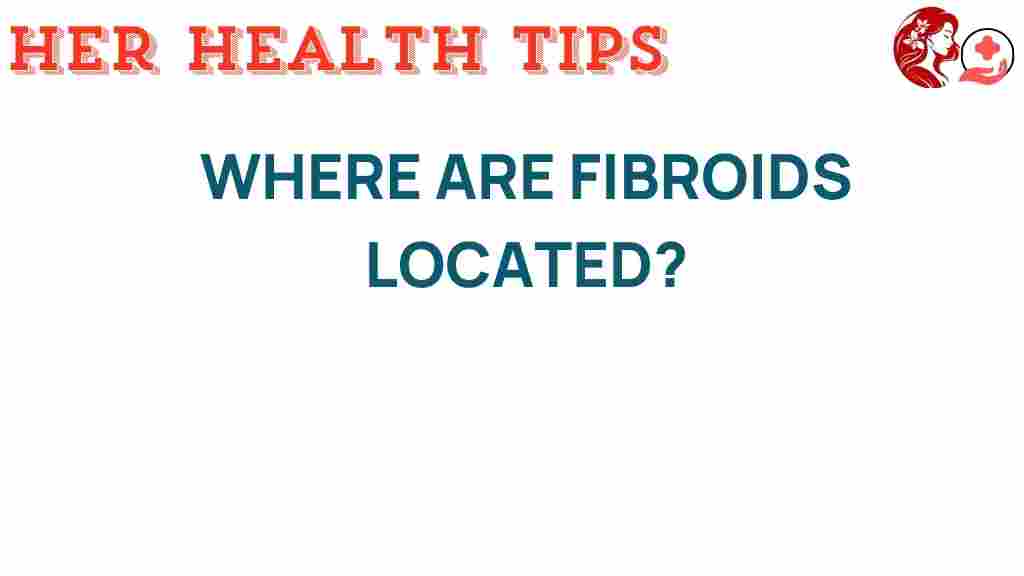Unveiling the Hidden Locations of Fibroids: What You Need to Know
Fibroids are non-cancerous growths that develop in or on the uterus, often affecting women’s health in various ways. Understanding their locations, symptoms, diagnosis, and treatment options is crucial for maintaining uterine health and overall reproductive system well-being. This comprehensive guide will unveil the hidden aspects of fibroids, empowering women with medical insights and health awareness.
Understanding Fibroids and Their Locations
Fibroids, also known as uterine leiomyomas, can vary in size, shape, and location. They can be classified based on where they develop within the uterus:
- Intramural Fibroids: These are the most common type and grow within the uterine wall.
- Subserosal Fibroids: Located on the outer wall of the uterus, they can extend outward, sometimes causing a bulge.
- Submucosal Fibroids: These grow beneath the lining of the uterine cavity and can impact menstrual flow significantly.
- Cervical Fibroids: These occur in the cervix and can cause complications during childbirth.
Each type of fibroid may present different symptoms and challenges for diagnosis and treatment, making it essential for women to be informed about their uterine health.
Symptoms of Fibroids
Many women with fibroids may not experience any symptoms, while others may face a range of issues. Common symptoms include:
- Heavy Menstrual Bleeding: This is one of the most prevalent symptoms, often leading to anemia.
- Pelvic Pain or Pressure: Women may feel discomfort or pain in the pelvic area.
- Frequent Urination: Larger fibroids can press against the bladder, leading to increased urination.
- Backache: Fibroids can cause pain in the lower back.
- Difficulty During Intercourse: Depending on their size and location, fibroids can make intercourse uncomfortable.
Recognizing these symptoms early can help women seek timely medical attention, which is crucial for uterine health and overall women’s health.
Diagnosis of Fibroids
Diagnosing fibroids typically involves several steps, including:
- Medical History Review: A healthcare provider will ask about symptoms, menstrual history, and any family history of fibroids.
- Pelvic Exam: A physical examination can help detect any abnormalities.
- Imaging Tests: Ultrasound is commonly used, but additional tests such as MRI or CT scans may be recommended for a detailed view.
- Hysteroscopy: In some cases, a hysteroscope can be inserted into the uterus to directly view fibroids.
It’s important for women to undergo regular check-ups and discuss any concerns with their healthcare providers to ensure early diagnosis and treatment.
Treatment Options for Fibroids
There are various treatment options available for managing fibroids, depending on their size, location, and the severity of symptoms. Here’s a breakdown of common treatment methods:
1. Watchful Waiting
If fibroids are small and asymptomatic, a doctor may recommend monitoring the condition without immediate intervention.
2. Medications
Several medications can help alleviate symptoms:
- Hormonal Treatments: Birth control pills and hormone therapy can help regulate menstrual cycles and reduce heavy bleeding.
- GnRH Agonists: These medications can shrink fibroids by blocking estrogen and progesterone.
- Nonsteroidal Anti-Inflammatory Drugs (NSAIDs): Pain relief medications can help manage discomfort.
3. Minimally Invasive Procedures
For women seeking less invasive options, consider:
- Uterine Artery Embolization (UAE): This procedure blocks blood flow to fibroids, causing them to shrink.
- Laparoscopic Myomectomy: Fibroids can be surgically removed using small incisions.
4. Surgical Options
In more severe cases, surgical options may be necessary:
- Open Myomectomy: This involves larger incisions and is used for larger fibroids.
- Hysterectomy: This is the complete removal of the uterus and may be considered for women with severe symptoms who do not wish to conceive in the future.
The choice of treatment should be made in consultation with a healthcare provider, taking into account the individual’s health goals and reproductive plans.
Step-by-Step Process for Managing Fibroids
Managing fibroids involves a proactive approach to uterine health. Here’s a step-by-step process to consider:
Step 1: Schedule Regular Check-Ups
Regular gynecological exams can help in early detection of fibroids. Discuss any symptoms with your healthcare provider.
Step 2: Monitor Your Symptoms
Keep a record of your menstrual cycle, any pain or discomfort, and how it affects your daily life. This information is crucial for your doctor.
Step 3: Explore Treatment Options
Work with your healthcare provider to explore the best treatment options based on your symptoms and lifestyle. Don’t hesitate to ask questions about each option.
Step 4: Consider Lifestyle Changes
Incorporating a balanced diet, regular exercise, and stress management techniques can help improve overall health and potentially alleviate some fibroid symptoms.
Step 5: Stay Informed
Educate yourself about fibroids, their impact on women’s health, and advances in treatment options. Resources like medical journals and health websites can be beneficial.
Troubleshooting Common Concerns
Women experiencing fibroids may have several concerns. Here are some common issues and tips to address them:
Concern 1: Heavy Bleeding
If heavy bleeding is a concern, consult with your doctor about potential medication adjustments or treatment options that can help.
Concern 2: Pain Management
Over-the-counter pain relievers can help, but if pain persists, it’s essential to discuss further options with your healthcare provider.
Concern 3: Fertility Issues
Fibroids can affect fertility, especially submucosal fibroids. If you are trying to conceive, discuss your options with a fertility specialist.
Concern 4: Emotional Impact
Living with fibroids can be emotionally taxing. Consider seeking support groups or counseling to help cope with any anxiety or stress.
Conclusion
In summary, understanding fibroids and their hidden locations is vital for women’s health and uterine health. Regular check-ups, awareness of symptoms, and exploring treatment options can significantly improve quality of life. Empower yourself with knowledge, stay proactive about your reproductive health, and don’t hesitate to seek medical insights when needed. For more information on women’s health and fibroids, visit this resource.
By maintaining health awareness, women can navigate the complexities of fibroids and make informed decisions for their health and well-being.
This article is in the category Reproductive and created by HerHealthTips Team
